engine AUDI A4 2018 Workshop Manual
[x] Cancel search | Manufacturer: AUDI, Model Year: 2018, Model line: A4, Model: AUDI A4 2018Pages: 403, PDF Size: 66.81 MB
Page 317 of 403
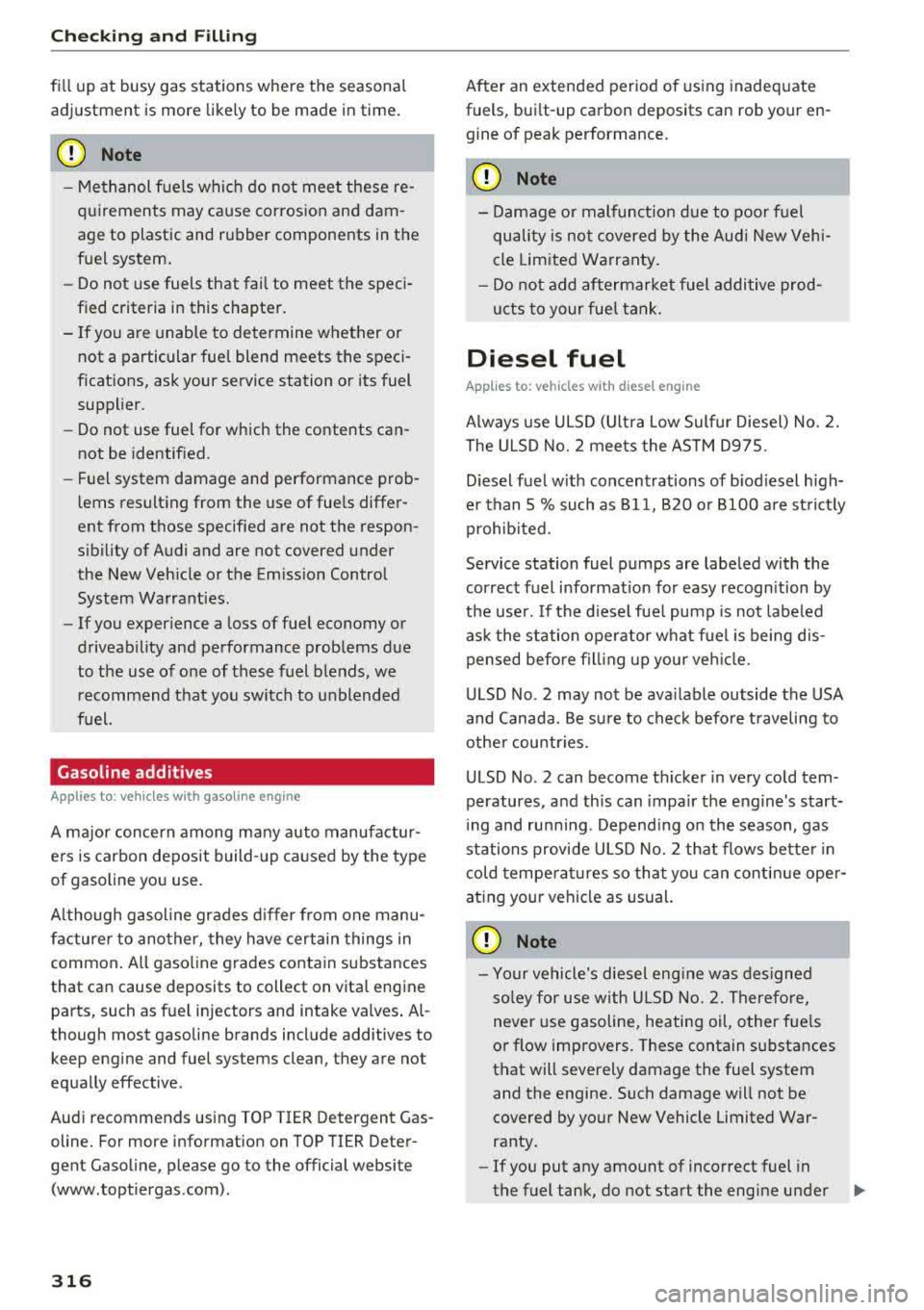
Checking and Filling
fill up at busy gas stations where the seasonal
adjustm ent is more likely to be mad e in time.
0 Note
- Methanol fuels which do not meet these re
quirements may cause corrosion and dam
age to plastic and rubber components in the
fuel system.
- Do not use fuels that fail to meet the speci
fied criteria in this chapter .
- If you are unable to determine whether or
not a particular fuel blend meets the speci
fications, ask your service station or its fuel
supplier.
- Do not use fuel for which the contents can
not be identified.
- Fuel system damage and performance prob
lems resulting from the use of fuels differ
ent from those specified are not the respon
sibility of Audi and are not covered under
the New Vehicle or the Emission Control
System Warranties.
- If you experience a loss of fuel economy or
driveability and performance problems due
to the use of one of these fuel blends, we
recommend that you switch to unblended
fuel.
Gasoline additives
Applies to: vehicles with gasoline engine
A major concern among many auto manufactur
ers is carbon deposit build-up caused by the type
of gasoline you use .
Although gasoline grades differ from one manu
facturer to another, they have certain things in
common. All gasoline grades contain substances
that can cause deposits to collect on vital engine parts, such as fuel injectors and intake valves.
Al
though most gasoline brands include additives to keep engine and fuel systems clean, they are not
equally effective .
Audi recommends using TOP TIER Detergent Gas
oline. For more information on TOP TIER Deter
gent Gasoline, please go to the official website (www.toptiergas .com) .
316
After an extended period of using inadequate
fuels, built-up carbon deposits can rob your
en
gine of peak performance.
([) Note
- Damage or malfunction due to poor fuel
quality is not covered by the Audi New Vehi
cle Limited Warranty.
- Do not add aftermarket fuel additive prod
ucts to your fuel tank.
Diesel fuel
Applies to: vehicles with diesel engine
Always use ULSD (Ultra Low Sulfur Diesel) No. 2.
The ULSD No. 2 meets the ASTM 0975.
Diesel fuel with concentrations of biodiesel high
er than 5
% such as 811,820 or 8100 are strictly
prohibited.
Service station fuel pumps are labeled with the
correct fuel information for easy recognition by
the user. If the diesel fuel pump is not labeled
ask the station operator what fuel is being dis
pensed before filling up your vehicle.
ULSD No. 2 may not be available outside the USA
and Canada. Be sure to check before traveling to
other countries.
ULSD No. 2 can become thicker in very cold tem
peratures, and this can impair the engine's start
ing and running . Depending on the season , gas
stations provide ULSD No. 2 that flows better in
cold temperatures so that you can continue oper
ating your vehicle as usual.
(D Note
- Your vehicle's diesel engine was designed
soley for use with ULSD No. 2. Therefore,
never use gasoline, heating oil, other fuels
or flow improvers. These contain substances
that will severely damage the fuel system
and the engine. Such damage will not be
covered by your New Vehicle Limited War
ranty.
- If you put any amount of incorrect fuel in
the fuel tank, do not start the engine under
.,..
Page 318 of 403

any circumstances. Immediately contact the
nearest authorized Audi dealer or author
ized Audi Service Facility for assistance.
These fuels contain substances that can se
verely damage the fuel system and the en
gine if the engine is started.
Refueling
Fuel filler neck
The fuel filler neck is located on the right rear
side panel behind the fuel filler flap.
If the power locking system should fail, you can
still open the flap manually
-for detailed instruc
tions see
¢page 319.
You can find the fuel tank capacity of your vehicle
in
¢page 381.
The label on the inside of the fuel filler flap tells
you the correct fuel for your vehicle. For more in
formation about fuel specifications, see
<=?page 315.
Your veh icle fuel tank has an onboard refuelling
vapor recovery system. This feature he lps to pre
vent fuel vapors from escap ing from the tank and
polluting the environment while you refuel your
vehicle . In order to fill the tank properly while
protecting the environment, please follow this
refueling procedure carefully.
A WARNING
Under normal operating conditions, never car
ry additional fuel containers in your car. Gas
canisters and other containers used to trans
port fuel can be dangerous. Such containers,
full or empty, may leak and could cause a fire
in a collision. If you must transport fuel to
use for your lawn mower, snow blower, etc.,
be very careful and always observe local and
state laws regarding the use, transportation
and storage of such fuel containers. Make cer
tain the container meets industry standards
(ANSI/ASTM F8S2
-86).
(D Note
Never dr ive your vehicle until the fuel tank is
completely empty. The irregu lar supply of
Checking and Filling
fuel can cause misfiring. Gasoline could enter
the exhaust system and damage the catalytic
converter.
Fueling procedure
Fig. 260 Right rear side of the vehicle: opening the fuel
f ilte r door
Fig. 261 Fuel filler door with attached fuel cap
The fuel filler door is unlocked or locked by the
central locking system.
Opening the fuel cap
.,. Press the left side of the fuel filler door to open
it¢
fig. 260 -arrow-.
.,. Unscrew the tank cap counterclockwise.
.,. Place the cap from above on the open fuel filler
door¢
fig. 261.
Closing the fuel cap
.,. Turn the fuel cap to the right until it stops.
.,. Close the fuel filler door until it latches.
Once the pump nozzle switches off, the fuel tank
is "full". Do not fill the tank more. Otherwise the
expansion space in the tank will be filled.
The correct fuel type for your vehicle can be
found on a label located on the inside of the fuel
.,.
317
Page 319 of 403
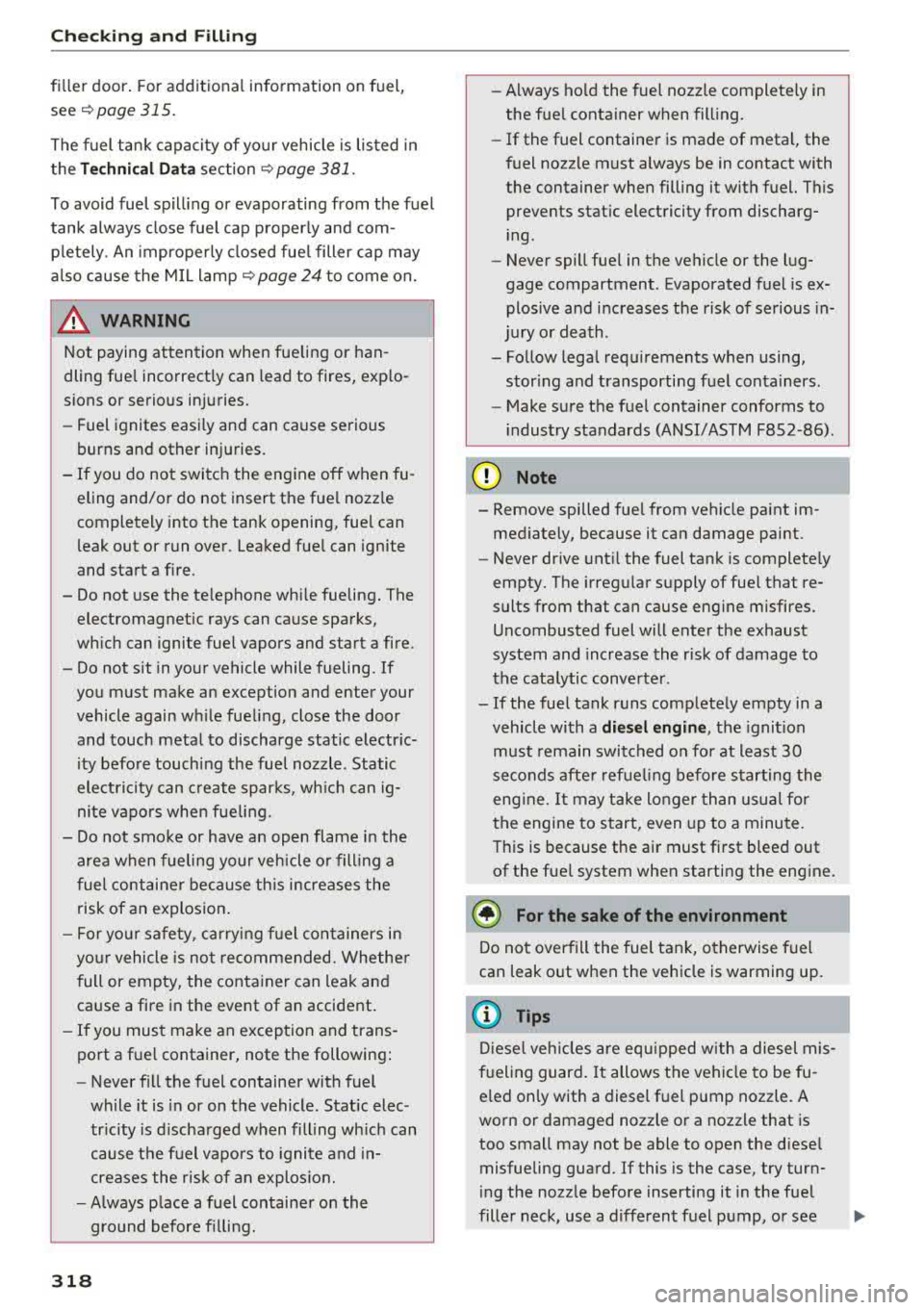
Checking and Filling
filler door. For additional information on fuel,
see
<=> page 315.
The fuel tank capacity of your vehicle is listed in
the
Technical Data section <=> page 381.
To avoid fuel spilling or evaporating from the fuel
tank always close fuel cap properly and com
pletely . An improperly closed fuel filler cap may
also cause the MIL lamp
<=>page 24 to come on.
A WARNING
Not paying attention when fueling or han
dling fuel incorrectly can lead to fires, explo
sions or serious injuries.
- Fuel ignites easily and can cause serious
burns and other injuries .
- If you do not switch the engine off when fu
eling and/or do not insert the fuel nozzle
completely into the tank opening, fuel can
leak out or run over. Leaked fuel can ignite
and start a fire .
- Do not use the telephone while fueling. The
electromagnetic rays can cause sparks,
which can ignite fuel vapors and start a fire.
- Do not sit in your vehicle while fueling. If
you must make an exception and enter your
vehicle again while fueling, close the door and touch metal to discharge static electric
ity before touching the fuel nozzle . Static
electricity can create sparks, which can ig
nite vapors when fueling.
- Do not smoke or have an open flame in the
area when fueling your vehicle or filling a
fuel container because this increases the
risk of an explosion .
-For your safety , carrying fuel containers in
your vehicle is not recommended. Whether
full or empty, the container can leak and
cause a fire in the event of an accident.
-If you must make an exception and trans
port a fuel container, note the following:
- Never fill the fuel container with fuel
while it is in or on the vehicle . Stat ic elec
tricity is discharged when filling which can
cause the fuel vapors to ignite and in
creases the risk of an explosion.
- Always place a fuel container on the
ground before filling.
318
-Always hold the fuel nozzle completely in
the fuel container when filling.
-If the fuel container is made of metal, the
fuel nozzle must always be in contact with
the container when filling it with fuel. This
prevents static electricity from discharg
ing .
-Never spill fuel in the vehicle or the lug
gage compartment . Evaporated fuel is ex
plosive and increases the risk of serious in
jury or death .
- Follow legal requirements when using, storing and transporting fuel containers .
-Make sure the fuel container conforms to
industry standards (ANSI/ASTM F8S2 -86).
{(D Note
- Remove spilled fuel from vehicle paint im
mediately, because it can damage paint.
- Never drive until the fuel tank is completely
empty. The irregular supply of fuel that re
sults from that can cause engine misfires.
Uncombusted fuel will enter the exhaust
system and increase the risk of damage to
the catalytic converter.
- If the fuel tank runs completely empty in a
vehicle with a
diesel engine, the ignition
must remain switched on for at least 30
seconds after refueling before starting the
engine.
It may take longer than usual for
the engine to start, even up to a minute.
This is because the air must first bleed out
of the fuel system when starting the engine.
@ For the sake of the environment
Do not overfill the fuel tank, otherwise fuel
can leak out when the vehicle is warming up.
@ Tips
Diesel vehicles are equipped with a diesel mis
fueling guard.
It allows the vehicle to be fu
eled only with a diesel fuel pump nozzle. A
worn or damaged nozzle or a nozzle that is
too small may not be able to open the diesel
misfueling guard. If this is the case, try turn
ing the nozzle before inserting it in the fuel
filler neck, use a different fuel pump, or see
..,_
Page 320 of 403
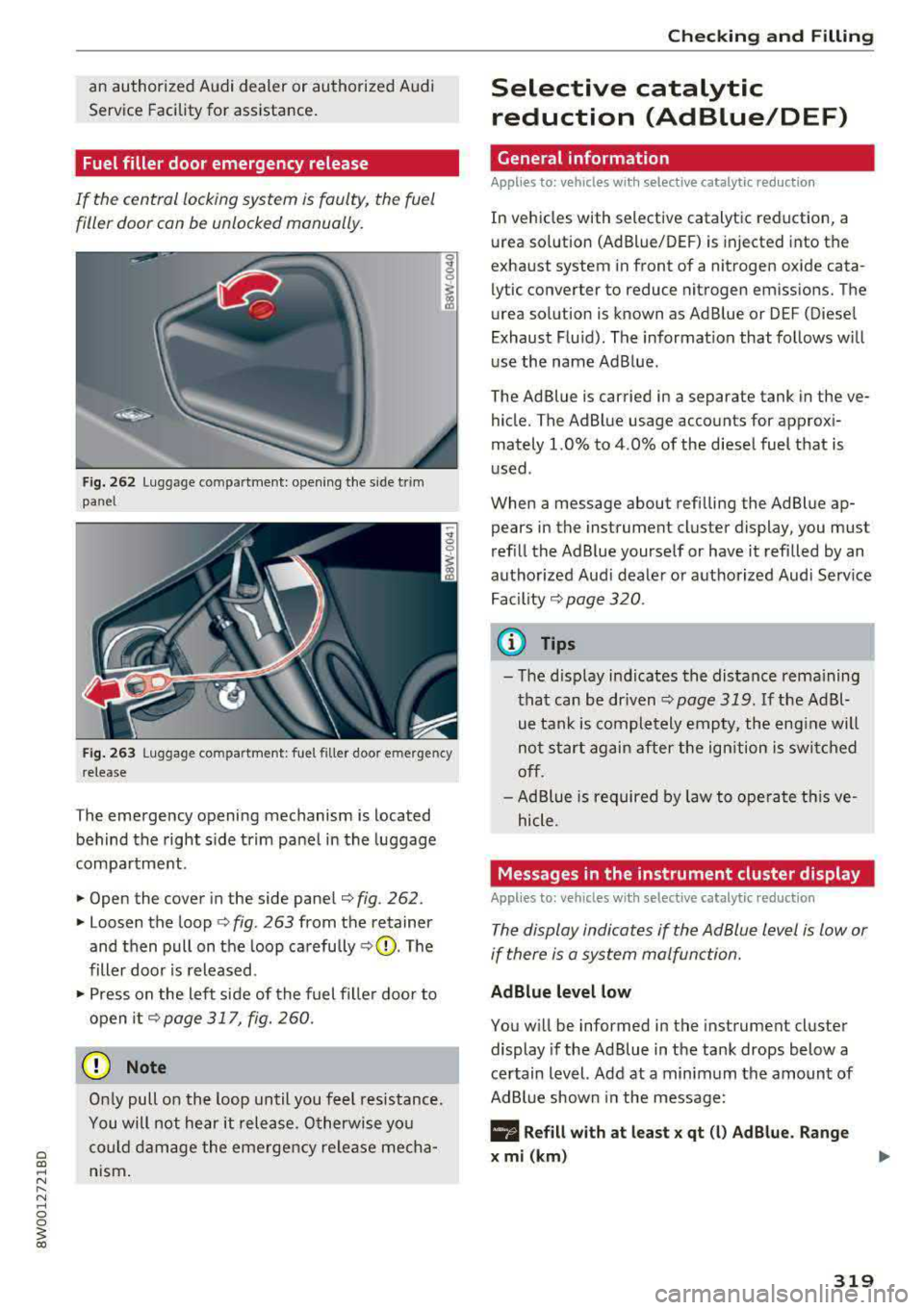
an authorized Audi dealer or authorized Audi
Service Facility for assistance.
Fuel filler door emergency release
If the central locking system is faulty, the fuel
filler door can be unlocked manually.
Fig. 262 Luggage co mpartment: opening the side trim
panel
Fig . 263 Luggage compartment: fuel filler door e merge ncy
r elease
The emergency opening mechanism is located
behind the right side trim panel in the luggage
compartment.
... Open the cover in the side panel ¢fig. 262.
... Loosen the loop c;, fig. 263 from the retainer
and then pull on the loop carefully
¢(D . The
filler door is released .
... Press on the left side of the fuel filler door to
open it
¢ page 317, fig. 260.
(D Note
Only pull on the loop until you feel resistance.
You will not hear it release . Otherwise you
could damage the emergency release mecha
nism.
Checking and Filling
Selective catalytic
reduction (AdBlue/DEF)
General information
Applies to: vehicles with selec tive catalytic reduction
In vehicles with selective catalytic reduction, a
urea solution (AdBlue/DEF) is injected into the
exhaust system in front of a nitrogen oxide cata
lytic converter to reduce nitrogen emissions. The
urea solution is known as Ad Blue or DEF (Diesel
Exhaust Fluid). The information that follows w ill
use the name AdBlue.
The Ad Blue is carried in a separate tank in the ve
hicle. The AdBlue usage accounts for approxi
mately 1.0% to 4 .0% of the diesel fuel that is
used .
When a message about refilling the AdBlue ap
pears in the instrument cluster display, you must
refill the AdBlue yourself or have it refilled by an
authorized Audi dealer or authorized Audi Service
Facility
c;, page 320 .
{D Tips
-The display indicates the distance remaining
that can be dr iven
c;, page 319. If the Ad Bl
ue tank is completely empty, the engine will
not start again after the ignition is switched
off.
-Ad Blue is required by law to operate this ve
hicle.
Messages in the instrument cluster display
Appl ies to: vehicles wi th selective catalytic reduction
The display indicates if the Ad Blue level is low or
if there is a system malfunction.
AdBlue level low
You will be informed in the instrument cluster
display if the AdBlue in the tank drops below a
certain level. Add at a minimum the amount of
AdBlue shown in the message:
II Refill with at least x qt (l) Ad Blue. Range
x mi (km )
319
Page 321 of 403
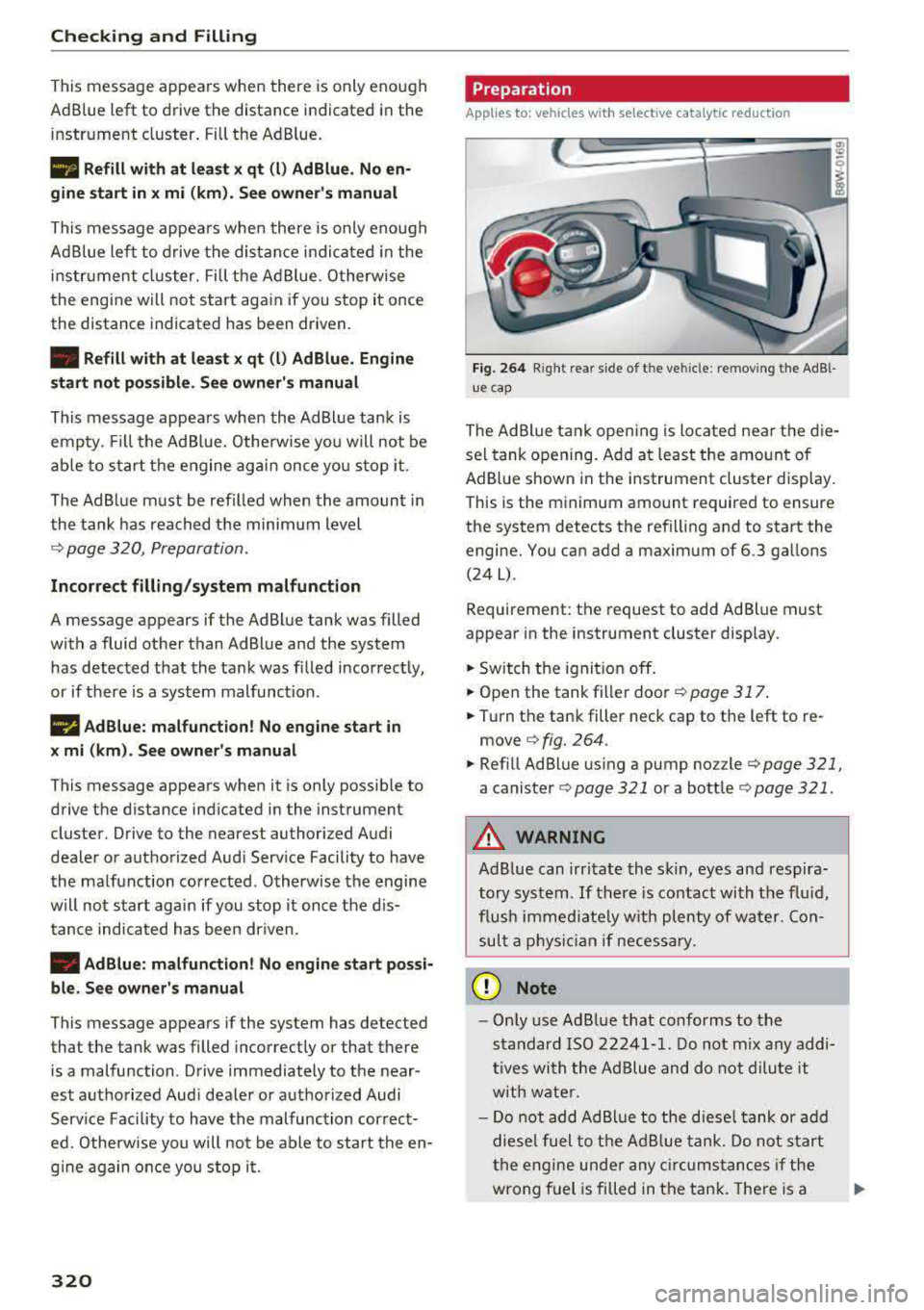
Checking and Filling
This message appears when there is only enough
Ad Blue left to drive the distance indicated in the
instrument cluster . Fill the Ad Blue .
• Refill with at least x qt (l) Ad Blue. No en
gine start in x mi (km). See owner's manual
This message appears when there is only enough
Ad Blue left to drive the distance indicated in the
instr ument cluster. Fill the Ad Blue. Otherwise
the engine will not start again if you stop it once
the d istance indicated has been driven .
• Refill with at least x qt (l) AdBlue. Engine
start not possible . See owner's manual
This message appears when the AdBlue tank is
empty. Fill the AdB lue. Otherwise you will not be
able to start the engine again once you stop it .
The AdBlue must be refilled when the amount in
the tank has reached the minim um level
c::> page 320, Preparation.
Incorrect filling/system malfunction
A message appears if the Ad Blue tank was filled
with a fluid other than AdBlue and the system has detected that the tank was fi lled incorrectly ,
or if there is a system malfunction .
II Ad Blue: malfunction! No engine start in
x mi (km). See owner's manual
This message appears when it is only possible to
drive the d istance ind icated in the instrument
cluster. Drive to the nearest authorized Audi
dealer or authorized Aud i Serv ice Facility to have
the malfun ction corrected. Otherwise the engine
will not start again if you stop it once the dis
tance indicated has been driven .
• Ad Blue: malfunction! No engine start possi
ble. See owner's manual
This message appears if the system has detected
that the tank was filled incorrectly or that there
is a malfunction . Drive immediately to the near
est authorized Aud i dealer or authorized Audi
Service Facility to have the malfunction cor rect
ed. Otherwise you will not be able to start the en
g in e again once you stop it .
320
Preparation
App lies to : vehicles with selective cata lyt ic reduct ion
Fig. 264 R ig ht re ar sid e o f th e ve hicle: removing th e Ad B l
ue cap
The Ad Blue tank open ing is located near the die
sel tank opening. Add at least the amount of
Ad Blue shown in the instrument cluster display.
This is the minimum amount required to ensure
the system detects the refilling and to start the
engine. You can add a maximum of 6 .3 gallons
(24
L) .
Requ irement: the request to add Ad Blue must
appear in the instrument cluster display .
.. Switch the ignition off.
.. Open the tank fille r doo r c::> page 317 .
.. Turn the tank filler neck cap to the left to re
move
c::> fig. 264 .
.. Refill Ad Blue using a pump no zzle c::> page 321,
a canister c::> page 321 or a bottle c::>page 321.
A WARNING
AdBlue can irritate the skin, eyes and respira
tory system .
If there is contact with the fluid,
flush immed iately w ith plenty of water . Con
sult a physician if necessary .
(D Note
-Only use Ad Blue that conforms to the
standard ISO 22241-1. Do not mix any addi
ti ves wi th the Ad Blue and do not dilute it
with water .
- Do not add AdBlue to the diesel tank or add
diesel fuel to the Ad Blue tank. Do not start
the engine under any circumstances if the
wrong fuel is filled in the tank. There is a
Page 322 of 403
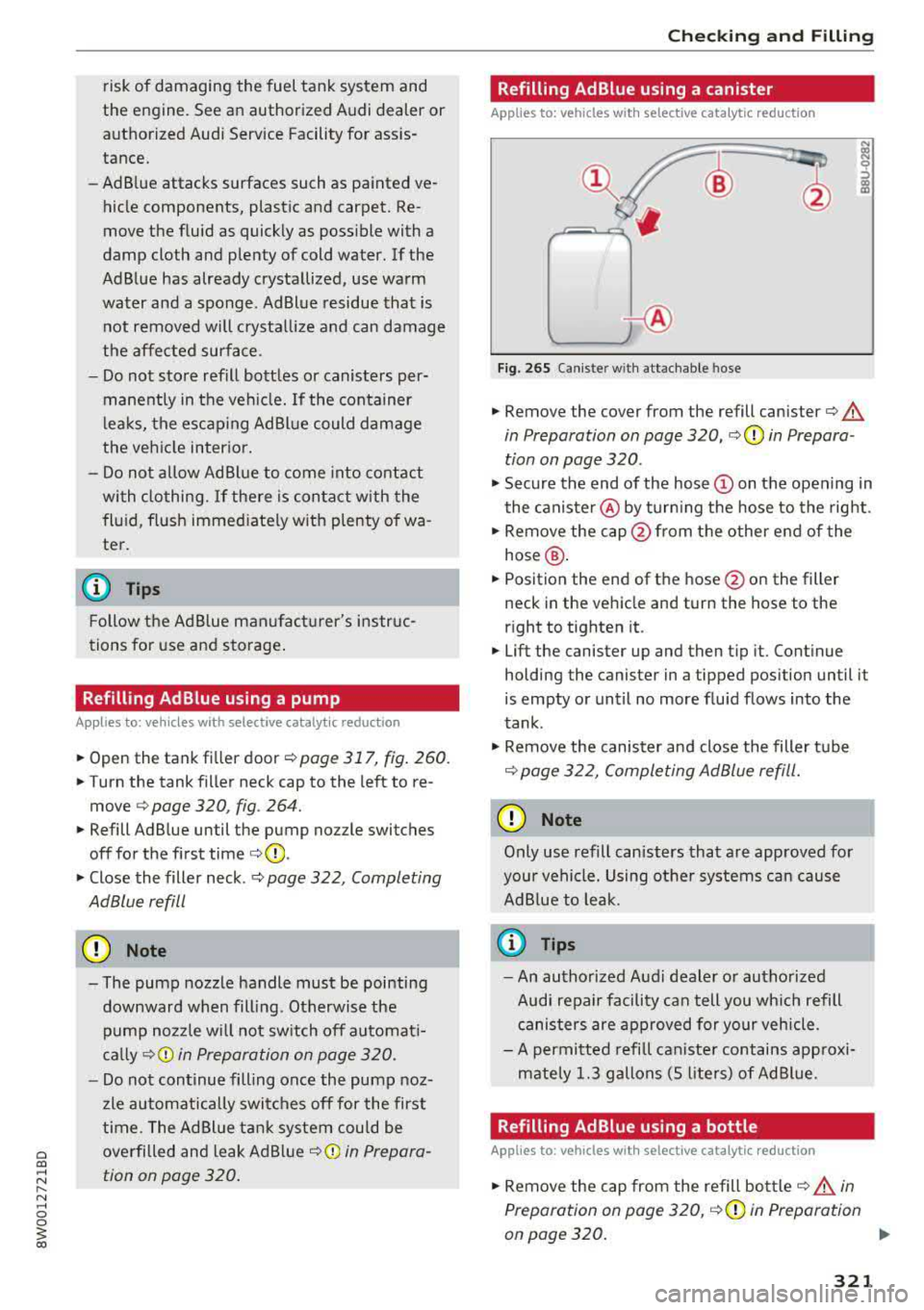
a co .... N ,....
N .... 0 0
3 co
risk of damaging the fuel tank system and
the engine . See an authorized Audi dealer or
authorized Audi Serv ice Facility for ass is
tance.
-Ad B lue attacks surfaces such as painted ve
hicle components, plastic and carpet. Re
move the fluid as quickly as poss ible with a
damp cloth and plenty of cold wa ter. If the
Ad Blue has already crystallized, use warm
water and a sponge . Ad Blue residue that is
not removed will crystallize and can damage
the affected surface .
-Do not store refill bott les or canisters per
manent ly in the veh icle. If the container
l ea ks, the escaping AdBl ue could damage
the veh icle inter ior.
-Do not allow AdBlue to come into contact
with clothing. If there is contact with the
fluid , flush immed iate ly w ith plenty of wa
ter.
@ Tips
F ollow the Ad Blue m anufact urer's instr uc
tions fo r use and storage .
Refilling AdBlue using a pump
Applies to: vehicles with selective catalytic reduction
.,. Open th e tank fi ller door ¢ page 317, fig . 260.
.,. T u rn the tank filler neck cap to the left to re
move
c:> page 320 , fig . 264.
.,. Refill AdBlue un til the pump no zzle swit ches
off for the first time ¢ (\1) .
.,. Close the filler neck . ¢ page 322, Completing
AdBlue refill
0 Note
-The pump nozzle handle must be pointing downward when filling . Otherwise the
pump noz zle w ill not sw itch
off automat i
ca lly
c:> Q) in Preparation on page 320.
-Do not continue filling once the pump noz
zle automatically switches
off for the first
time . The AdBlue ta nk system could be
overfilled and leak Ad B lue
c:> (D in Prepara
tion on page 320 .
Check ing and Filling
Refilling AdBlue using a canister
Applies to: vehicles with selective catalytic reduction
+®
Fig. 265 Can is te r w it h attachab le hose
.,. Remove the cover from the refill canis te r¢ .&.
in Preparation on page 3 20, ¢ (Din Prepara
tion on page 320 .
.,. Secure the end of the hose(!) on the open ing in
t he canister @by turn ing the hose to the rig ht.
.,. Remove the cap @from the other end of the
hose @ .
.,. Position the end of the hose @ on the filler
neck in the vehicle and turn the hose to the
r ight to tighten it .
.,. Lift the canister up and then tip it. Cont inu e
holding the canis ter in a tipped pos it ion until i t
is empty or until no more flu id flows into the
tank .
.,. Remove the canis ter and close the filler t ube
c:> page 322, Completing AdBlue refill .
(D Note
Only use refill canisters that a re approved fo r
your vehicle. Using ot her systems ca n cause
Ad B lue to leak.
© Tips
- An authorized Aud i dealer o r autho rized
Audi repair facility can tell you wh ich refill
canisters are approved for your vehicle.
- A permitted refill ca niste r contains app roxi
mately 1.3 gallons (5 l ite rs) of Ad Blue .
Refilling AdBlue using a bottle
Applies to: vehicles with selective catalytic reduction
.,. Remove the cap from the refill bo ttle c:> .&. in
Preparation on page 3 20,
c:> (D in Preparation
on page 320 .
.,.
321
Page 323 of 403

Check ing and F illing
"' Position the bottle on the filler tube and turn
the bottle clockwise unti l it stops turning.
"' Press lightly aga inst the bottom of the bott le
to empty it. Continue pressing the bottom of
the bottle until it is empty or unti l fluid stops
flowing into the tank .
"' Remove the bottle and seal the filler neck
¢ page 322, Completing AdBlue refill .
0 Note
Only use refill bottles that are approved for
your vehicle. Us ing other systems can ca use
Ad Blue to leak.
-You can obta in refill bottles from an author
i zed Audi dealer or authorized A udi Service
F ac ility.
- A pe rm itted refill bottle conta ins approxi
mately 0 .5 gallon ( 1.9 liters) of Ad Blue.
Completing AdBlue refill
Applies to: vehicles with selective catalytic reduction
Closing the filler neck
"'Turn the Ad Blue cap to the r ight on the filler
tube unti l th e cap cl ic k s into
p lace ¢.&. in
Prepara tion on page 320,
¢ (Din Preparation
on page 320 ..
"' Then press on the left side of the tank door un-
ti l it latches.
After filling
The vehicle must be driven so tha t the system
recognizes t hat the Ad B lue was refilled. This can
t ake severa l m in utes.
"' If there was no Ad Blue left in the tank and a
r ange of O mi (0 km) was shown in the d isplay,
swi tch the ign ition on fo r abo ut 30 seconds be
f ore star ting the engine .
(D Tips
Ad Blue in the tank can free ze at very low tem
pera tures. If this happens, the system will
not detect that the AdB lue was refilled and it
w ill contin ue to inform you of the low AdBlue
322
leve l. The message tu rns off as soon as the
tank thaws out again .
Emissions control
systems
Cat alytic converter
Applies to: vehicles with gasoline engines
T he vehicle may only be driven w ith un leaded
gaso line, otherwise the catalytic converter will be
destroyed .
Never drive unti l the tan k is comp lete ly empty .
T he irregu lar supply of fuel that resu lts from that
can cause eng ine misfires. Uncombusted fuel will
enter the exhaust system , which can cause over
heating and damage to the catalytic converte r.
Di esel particulate filt er
Applies to: vehicles with diesel engines
The diese l particulate filter filters nearly all of
the soot part icles out of the exhaust. The filter
cleans itself automat ica lly under norma l dr iv ing
cond it io ns. If the filter cannot clean itself (for ex
amp le, because yo u are on ly driving short distan
ces), the filter becomes clogged with soot and
the
1111 i ndicato r light for the diese l particulate
filte r tu rns
on ¢ page 33.
_&. WARNING
The tempera ture o f the e xhaust sys tem is
h igh, both when driving and a fter stopping
the engine.
-
-Never tou ch the e xhaus t tail p ipes o nce they
have become hot. This cou ld resu lt in burns.
-D o not p ark your vehicle over flamm able
materials such as grass or leaves because
the hig h temperature of the emissions con
trol system (catalyt ic converter or d iese l
pa rticu late filter) co uld start a fire.
- Do not apply underbody protectant in the
exhaust system area, beca use this increases
the risk of f ire.
Page 324 of 403

a co .... N ,....
N .... 0 0
3 co
Engine compartment
Working in the engine compartment
Special care is required if you are working in the
engine compartment
F or wo rk in th e en gine c ompar tment , suc h as
ch eckin g and fi llin g flu id s, th ere is a risk of in
j u ry , sca lding , acci dent s, a nd b urn s. Fo r this
re aso n, follow all the warnin gs and ge nera l
safet y pr eca uti ons pr ov ided in the follow ing in
form ation . Th e e ng ine c ompartm en t is a d an
ger ous a re a .
~ ,&. .
_& WARNING
- T urn the engine off.
- Switch the ign ition off .
- Set the parking brake .
- Shift the gearshift lever to neutral in vehicles with a manual transm ission and se
lect the P selector lever posit ion in vehicles
with an automatic transmission .
- Let the engine coo l down.
- Never open the hood when there is steam or coolant escaping from the eng ine compart
ment, because there is a risk that you cou ld
be burned . Wait until no steam or coolant is
escaping.
- Keep children away from the engine com
partment.
- Never spill flu ids on a hot engine. These flu
ids (such as the anti-freezing agent con
tained in the coolant) can ignite.
- Avoid sho rt circu its in the e lectrical system.
- When working in the engine compartment,
remember that the radiator fan can sw itch
on even if the ign ition is switched off , which
increases the risk of inj ury .
- Never open the cap on the coolant expan
sion tank when the eng ine is warm. The
cooling system is under press ure.
- T o protect your face, hands, and arms from
hot steam or coolant, cover the cap with a
large cloth when opening.
- Do not remove the eng ine cover under any
c ircumstances . This increases the risk of
burns .
Check ing and Filling
-If tests need to be performed with the en
gine running, there is add itiona l danger due
to mov ing components (such as the ribbed
belt, alternator and radiator fan) and from
the high-voltage ignition system.
-Do not under any circumstances activate the
throttle inadvertently (for example, by hand
from the engine compartment) if the veh i
cle is stat ionary but the eng ine is running
and a gea r is engaged. Otherwise, the veh i
cle will start to move immed iate ly and this
could result in an accident.
- Pay attent ion to the following warn ings
when wor k on the fue l system is required :
- Do not smoke.
- Never work near open flames.
-Always have a working fi re extinguisher
nearby.
-All work on the battery or electrical system in your vehicle can result in injuries, chemi
cal burns, accidents or burns. Because of
this, all work must be performed
o nly by an
author iz ed Audi dealer or author iz ed Audi
Serv ice Facility.
-To reduce the r isk of electric shock and in
jury, never touch the following components
when the engine is runn ing or is being start
ed:
- Ign ition cable
- Other components in the e lectronic high-
vo ltage ign ition system
-I f you must check or perform wo rk on the
engine wh ile it is running:
-First, set the parking brake and and move
the gearshift lever to neutral (for manual
transm issions) or select the P selector lev
er position (for automatic transm iss ions).
- Always proceed w ith extreme caution so
that clothing, jewelry or long hair do not become caught in the radiator fan, fan
belt or other moving components or do
not come into contact with hot compo
nents. Tie bac k long hair befo re beginning
work and do not wear clothing that can hang down into the engine.
-Lim it your exposure to exhaust and chemi
cals to as short a time as possible
¢ .&. .
32 3
Page 325 of 403
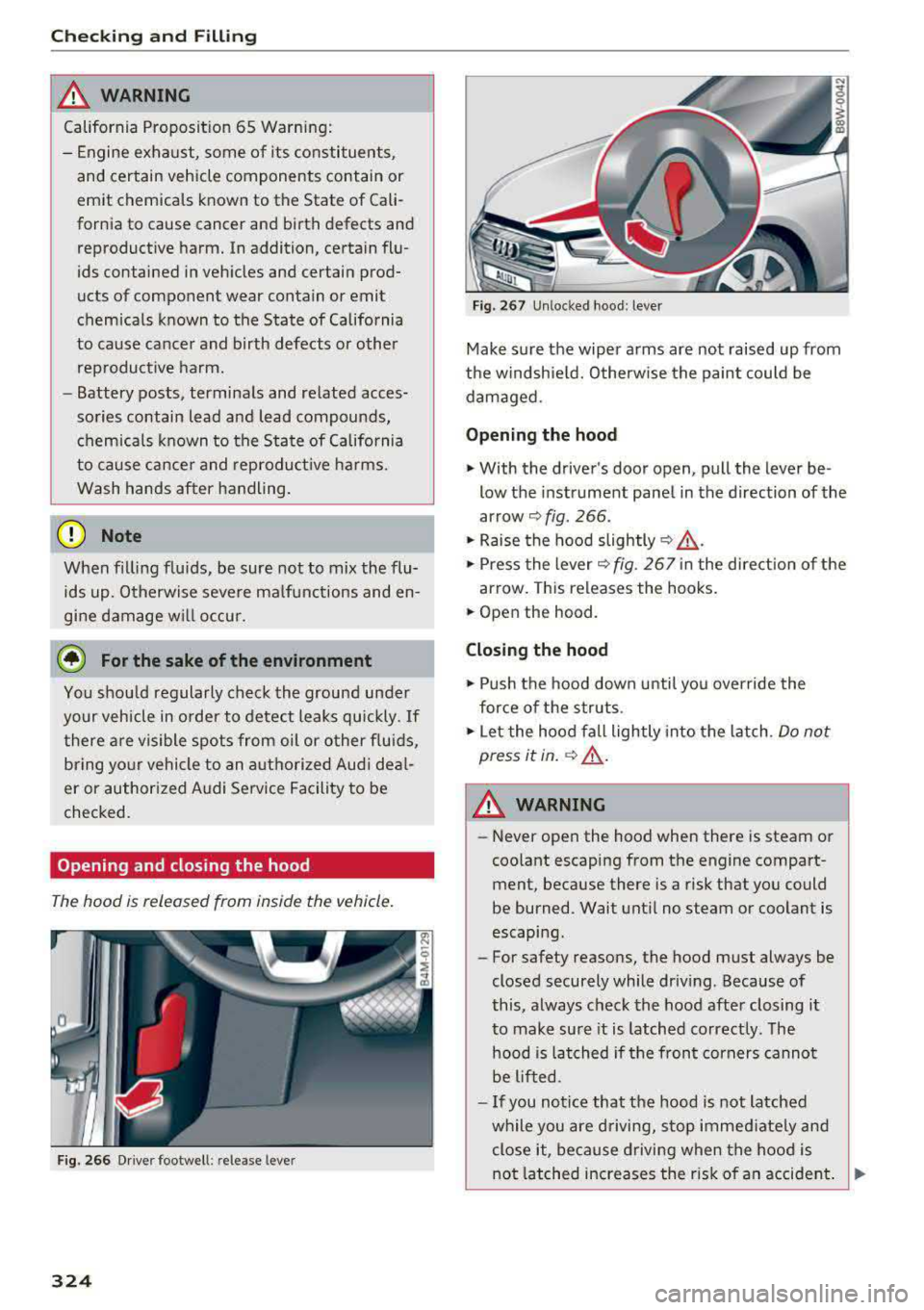
Checking and Filling
_& WARNING
California Proposition 65 Warning:
- Engine exhaust, some of its constituents ,
and certain vehicle components contain or emit chemicals known to the State of Cali
fornia to cause cancer and birth defects and reproductive harm. In addition, certain flu
ids contained in vehicles and certain prod
ucts of component wear contain or emit
chemicals known to the State of California
to cause cancer and birth defects or other reproductive harm.
- Battery posts, terminals and related acces
sories contain lead and lead compounds, chemicals known to the State of California
to cause cancer and reproductive harms.
Wash hands after handling.
(D Note
When filling fluids, be sure not to mix the flu ids up . Otherwise severe malfunctions and
en
gine damage will occur.
@ For the sake of the environment
You should regularly check the ground under
your vehicle in order to detect leaks quickly . If
there are visible spots from oil or other fluids,
bring your vehicle to an authorized Audi deal
er or authorized Audi Service Facility to be
checked.
Opening and closing the hood
The hood is released from ins ide the vehicle.
Fig. 266 Drive r footwell : rele ase le v er
324
Fig. 267 Unlocked hood: lev er
Make sure the wiper arms are not raised up from
the windshield. Otherwise the paint could be
damaged .
Opening the hood
"'With the driver's door open, pull the lever be
low the instrument panel in the direction of the
arrow
9 fig . 266 .
"' Raise the hood slightly 9 ,&.
"'Press the lever ~ fig. 267 in the direction of the
arrow. This releases the hooks.
"' Open the hood.
Closing the hood
"' Push the hood down until you override the
force of the struts .
"'Let the hood fall lightly into the latch . Do not
press it in.
9 ,& .
_& WARNING
-Never open the hood when there is steam or
coolant escaping from the engine compart
ment, because there is a risk that you could
be burned. Wai t until no steam or coolan t is
escaping.
- For safety reasons, the hood must always be
closed securely while driving . Because of
this, always check the hood after closing it
to make sure it is latched correctly . The
hood is latched if the front corners cannot
be lifted .
- If you notice that the hood is not latched
while you are driving, stop immediately and
close it, because driving when the hood is
not latched increases the risk of an accident.
,...
Page 326 of 403
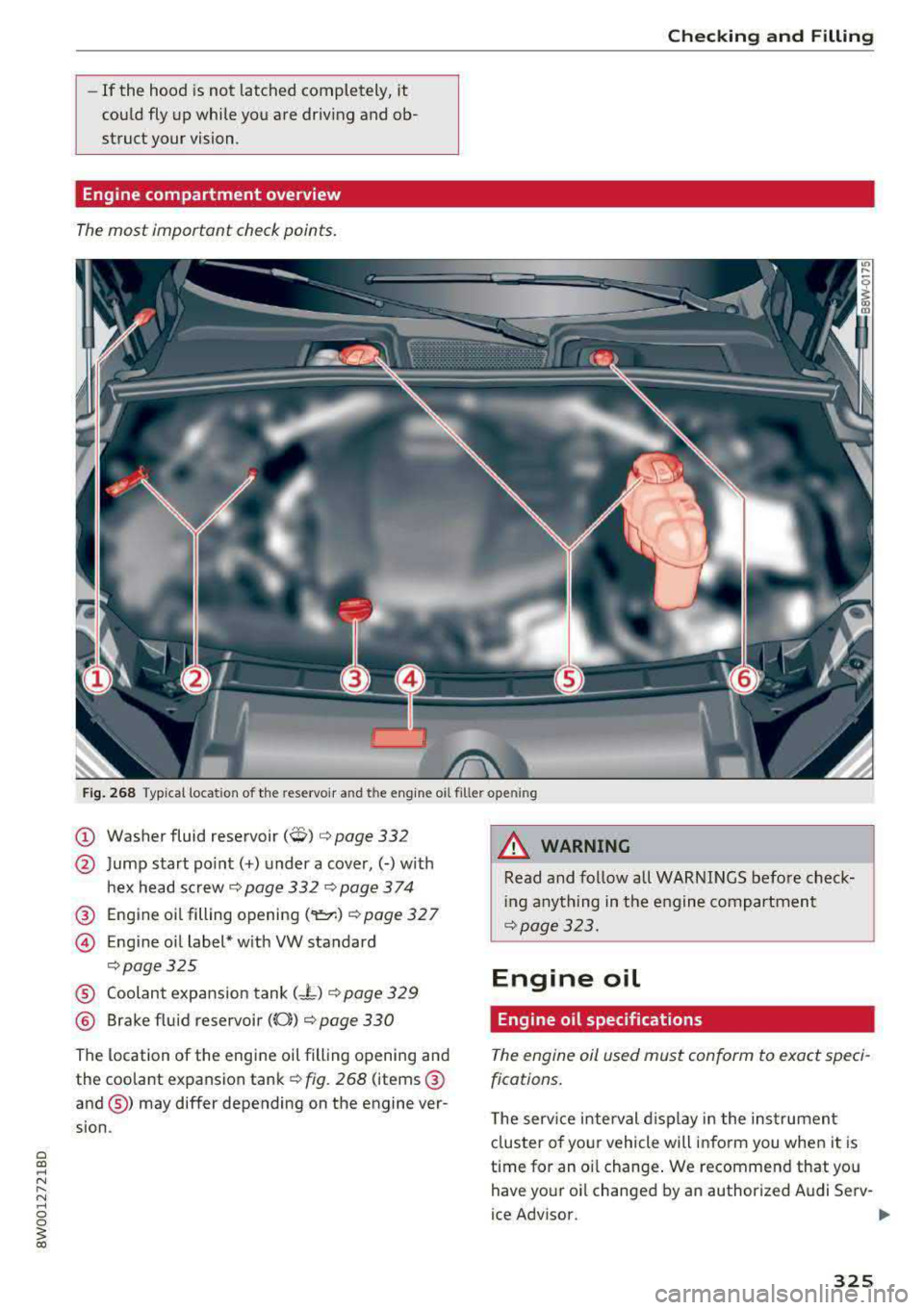
-If the hood is not latched completely, it
could fly up while you are driving and ob
struct your vision.
Engine compartment overview
The most important check points.
Checking and Filling
Fig. 268 Typical location of the reservoir a nd t he engine o il filler ope ning
(!) Washer fluid reservoir (O) c::> page 332
@ Jump start po int( +) under a cover,(-) w ith
hex head screw
¢page 332 c:>page 374
@ Engine oil filling opening (
c:> page325
® Coolant expansion tank (- L) c::> page 329
® Brake fluid reservoir ((0) c::> page 330
The location of the engine oil filling opening and
the coolant expansion tank ¢
fig. 268 (items@
and@) may differ depending on the engine ver
sion .
_& WARNING
-Read and follow all WARNINGS before check-
in g anything in the engine compartment
c:> page 323.
Engine oil
Engine oil specifications
The engine oil used must conform to exact speci
fications.
The service interval display in the instrument
cluster of your vehicle will inform you when it is
time for an oi l change . We recommend that you
have your oil changed by an authorized Audi Serv-
ice Advisor.
.,..
325